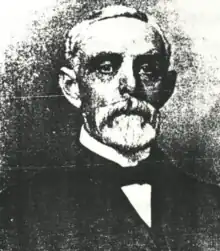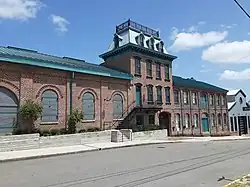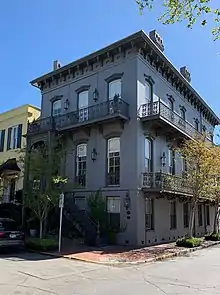William Kehoe | |
|---|---|
 Kehoe around 1920 | |
| Born | August 21, 1842 Wexford, County Wexford, Ireland |
| Died | December 29, 1929 (aged 87) Savannah, Georgia, U.S. |
| Occupation | Businessman |
William Kehoe (August 21, 1842 – December 29, 1929) was an Irish businessman who emigrated to Savannah, Georgia. He became a successful iron founder.
Life and career


Kehoe was born on August 21, 1842, in Wexford, County Wexford, Ireland, to Daniel Kehoe and Johanna Rath. He was one of seven children,[1] including another son, Patrick, who was born in 1830. His family emigrated to the United States in 1851, arriving in Savannah, Georgia, on February 28,[1] and settling in the Old Fort neighborhood, an Irish enclave in the city.[2][3] His father died, at the age of 51 or 52, shortly after their arrival, during a yellow fever epidemic.[1]
During the Civil War, Kehoe made bullets in Selma, Alabama, for the Confederate Army.[1] After returning to Savannah, he learned the trade of an iron molder.[2] He began working for Savannah Machine and Boiler Works.[4]
On November 26, 1868, seven months after the death of his mother, he married Savannah native Anne Flood,[2] with whom he had ten children. A daughter, Annie, died in infancy in 1876.[4] He named son Francis Parnell Kehoe after pro-tenant Irish National Land League leader John Howard Parnell.[3]
By 1873, a foundry now known as Phoenix Iron Works had been built at today's 660 East Broughton Street, in the Trustees' Garden,[5] in Savannah.[4] It was owned by James Monahan, who had left Savannah Machine and Boiler Works to start out on his own. He brought Kehoe and John Rourke with him.[1] Four years later, Monahan sold the foundry to Thomas Mulligan and set up a new location, a few hundred feet away, called Phoenix Architectural Works. Kehoe was a foreman there by 1877.[1]
In 1879, Kehoe and Ellen Monahan, widow of James, were made co-owners of the business. Kehoe bought Monahan's share of the business the following year and renamed it Kehoe Iron Works.[4][1] Around a decade later, the property was purchased by the Savannah Gas Company,[5] and Kehoe moved to a new building on the Savannah River. He passed the iron works business to his sons Simon and William.[1] Kehoe was listed as its chairman in 1912.[6]
Over the next fifty years, Kehoe grew one of the best-equipped marine engineering stores on the South Atlantic coast.[2]
He was also a founder of the Chatham Savings and Loan Company, and was its president at the time of his death. He was also a director of the National Bank of Savannah and Savannah Electric and Power Company, a founder of the Tybee Railroad and was a member of the Tybee Island's town council for 25 years. He was on the Board of Commissioners of Chatham County between 1893 and 1898.[2]
Among his many benevolent and religious affiliations, he was a member of the Georgia Historical Society.[2]
In 1885, Kehoe had built a home at 130 Habersham Street in Savannah's Columbia Square. Seven years later, after both his business and family expanded, he built another home, known as the Kehoe House, diagonally across the square, into which he and his family moved upon its completion in 1892.[7][8] The latter property is now a 15-room inn,[9] and is one of three "Historic Inns of Savannah," the other two being The Gastonian, at 220 East Gaston Street, and the Eliza Thompson House Bed and Breakfast, at 5 West Jones Street.[10]
The inn is owned by Savannah's HLC Hotels, Inc., which also owns the city's Olde Harbour Inn, the Eliza Thompson House, the East Bay Inn and The Gastonian.[11]
Kehoe sold the family home after the death of his wife in 1920 and moved to East 36th Street.[4]
Death
Kehoe died of pneumonia on December 29, 1929, in Savannah. He was 87.[4] He was one of the city's oldest residents at the time of his death,[2] and was survived by seven of his children.[1]
His funeral was held at the Cathedral of St. John the Baptist, of which he was a member. He is interred in Savannah's Catholic Cemetery, on Wheaton Street, with almost all of his family. (It is not known where infant Annie was buried, and Kehoe's son, Daniel, was interred in Savannah's Greenwich Cemetery upon his death in 1954.)
References
- 1 2 3 4 5 6 7 8 9 Causey, Carol (1991-11-01). "William Kehoe: Fulfilling the American Dream". Savannah Biographies.
- 1 2 3 4 5 6 7 The Bulletin of The Catholic Laymen's Association of Georgia, January 4, 1930
- 1 2 "Man of Iron: William Kehoe". Freeman's Rag. Retrieved 2022-03-19.
- 1 2 3 4 5 6 Edenfield, Enocha. "Boo Business: William Kehoe, the Irish legend behind the famed Savannah ghost story". Savannah Morning News. Retrieved 2022-03-19.
- 1 2 News, Molly Hayden For Savannah Morning. "Kehoe Iron Works forges new mission". Savannah Morning News. Retrieved 2022-03-19.
{{cite web}}:|last=has generic name (help) - ↑ The American Employer, Volumes 1-2. American Employer Publishing Company. 1912. p. 190.
- ↑ Historic Building Map: Savannah Historic District – Historic Preservation Department of the Chatham County-Savannah Metropolitan Planning Commission (November 17, 2011)
- ↑ History – KehoeHouse.com
- ↑ "What's Doing in Savannah" – New York Times, April 6, 1997
- ↑ 3 Historic Savannah Inns – Historic Inns of Savannah
- ↑ Our Properties - HLC Hotels